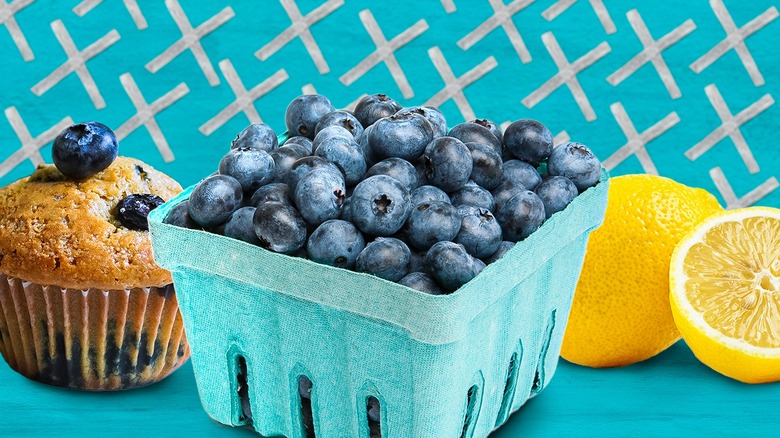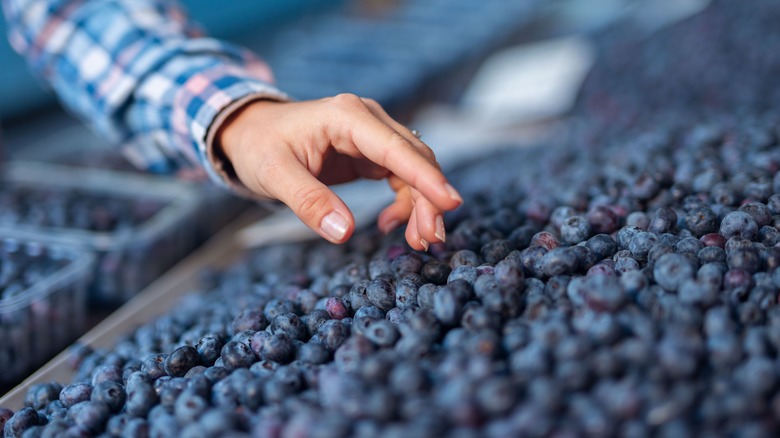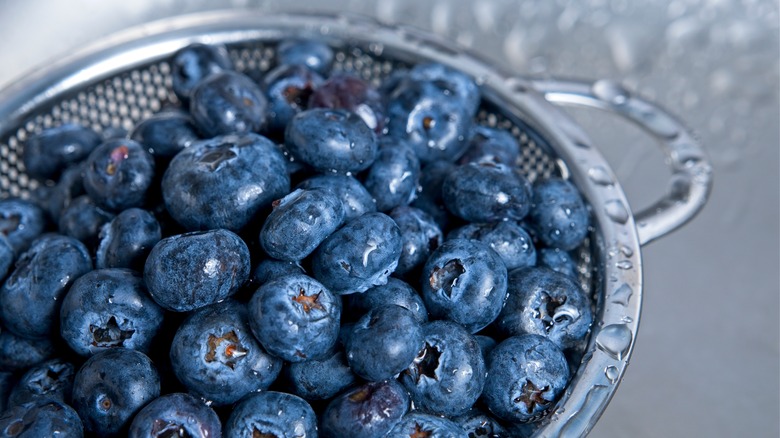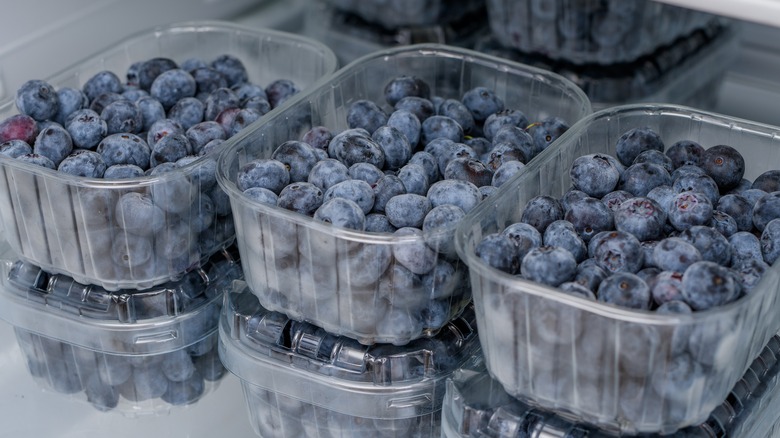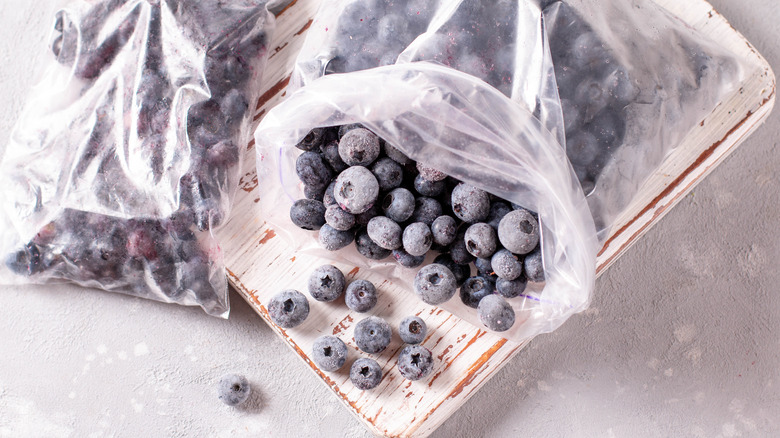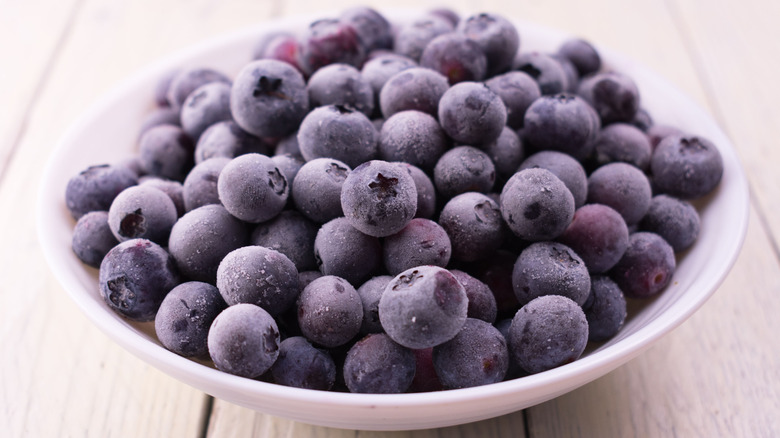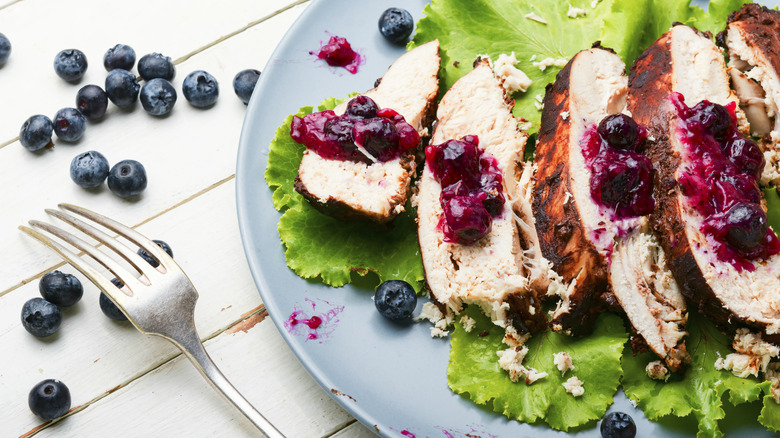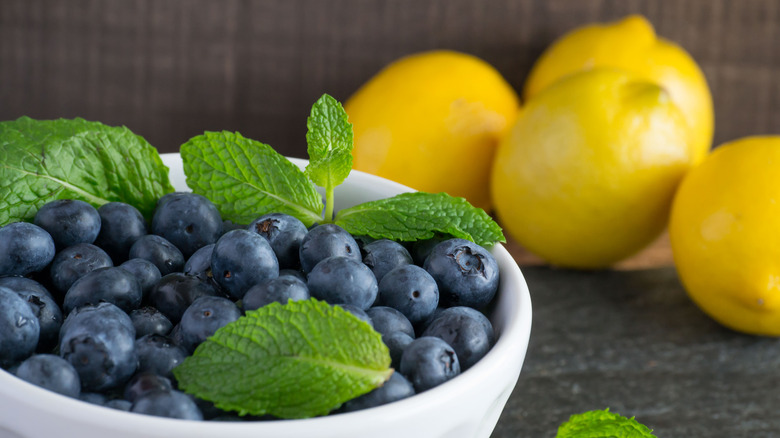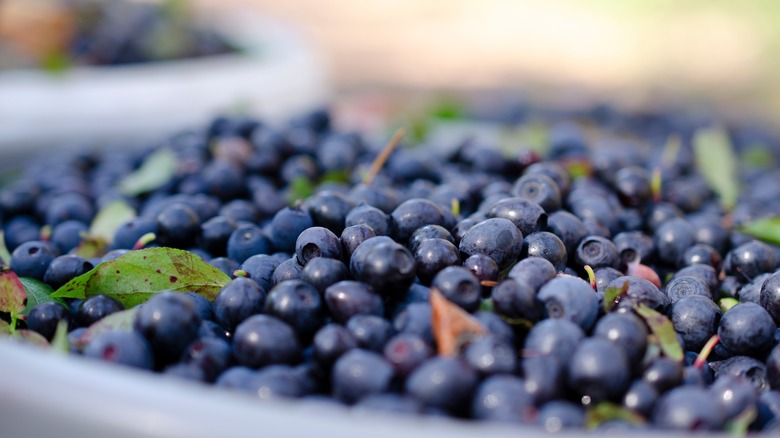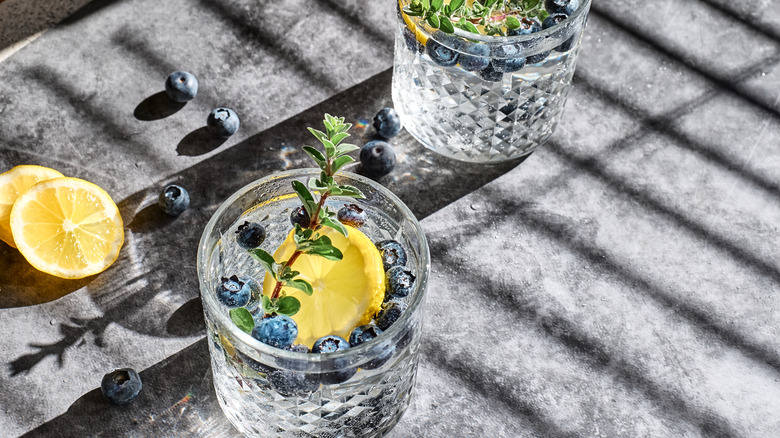10 Mistakes You Have To Stop Making With Blueberries, According To A Cookbook Author
Summertime is synonymous with long, sunny days and fresh, juicy blueberries. These vibrant little berries are the quintessential summer fruit, bursting with sweet flavor and beneficial nutrients. Blueberries are versatile, utterly delightful, and can be enjoyed anytime, from morning blueberry pancakes and an afternoon smoothie to an after-dinner cobbler and late-night snack. Whether you're eating them straight from the bush, adding them to a parfait, cooking them into a sauce, or baking them into a pie, blueberries bring a taste of summer to every bite.
With endless blueberry possibilities throughout the day (and year, thanks to frozen berries), knowing how to handle them properly is crucial — from picking and washing to storing and cooking. For expert advice, I spoke to Sally Vargas, author of "The Blueberry Cookbook" and writer of a weekly recipe column for The Boston Globe's Wednesday Food Section. Here's everything you need to know to avoid common mistakes and make the most of your blueberries.
1. Choosing the wrong ones
Selecting perfectly ripe blueberries can be tricky, as they often appear similar at first glance. While a container of blueberries may look appealing at the grocery store, you might find moldy, sour, or underripe berries lurking beneath the top layer once you get home. It may feel a bit awkward, but there's no harm in spreading the blueberries onto a paper towel to inspect the lower layers before making your purchase.
Vargas advises to look "for deep blue- or deep purple-colored berries" while avoiding green or reddish berries that are probably underripe. But color is not the only indicator of ripeness. The presence of a white or silvery bloom on the skin of blueberries is a good sign. This edible, natural, waxy coating is a protective barrier that keeps the blueberries fresh. The bloom tends to fade as the berries age after picking, so the more bloom you see, the better sign that the berries were picked at peak ripeness.
When it comes to blueberries, size matters, but it also depends on the type of blueberries you're shopping for. Cultivated berries, known as high bush berries, are large and grown in all parts of the world. On the other hand, wild blueberries, known as low bush berries, are tiny, grown close to the ground, and have a very short season. "You often find people selling them on the side of the road in Maine in August," adds Vargas. "Otherwise, they are available frozen all year round."
2. Washing them incorrectly
As with all fruit with edible skins, it's a good idea to rinse blueberries well before eating. This step helps remove any dirt, bacteria, or pesticides that may be clinging to the surface. If you scour the internet, you will come across suggestions like washing with a mixture of water and vinegar or even baking soda, known for its natural cleaning properties.
Our expert's advice? Plain water is the ideal choice and all that's needed for cleaning your blueberries. "Rinse in a colander under cold water, so the water can flow through, and the berries can drain," recommends Vargas. "After draining, spread them on a paper towel or dish towel and gently pat them dry with a second towel." However, if you don't plan to eat the berries right away, Vargas advises against washing them in advance to prevent mold or sogginess from forming in the refrigerator during storage. Instead, store them unwashed in the refrigerator and give them a quick rinse just before eating.
3. Storing them the wrong way
After correctly washing and drying your blueberries, you may decide to relax and eat a bowl of the juicy little gems in one sitting. But if that's not your plan — or you end up having leftovers — you'll need to store the blueberries in the refrigerator so they stay as fresh as possible for as long as possible.
The container you use to store your blueberries plays a crucial role in how long they keep. Vargas likes using a breathable container that allows for air circulation to keep the berries dry and fresh. She advises lining the container with paper towels before filling it and warns against overcrowding the small, delicate-skinned berries. According to Vargas, you can also use the original carton or ventilated plastic clamshell in which store-bought berries often come packaged.
It's also essential to store your blueberries in the proper place in your refrigerator. Vargas suggests storing them in the "main compartment of the fridge (not the crisper drawer) which has more air circulation and [the] coolest temperature."
4. Avoiding freezing them
Frozen fruit and berries often get a bad rap for turning mushy when thawed. However, blueberries are an exception, as they freeze beautifully, retaining both their texture and flavor remarkably well. Unless you plan to use a lot of fresh blueberries for a pie or cobbler, consuming all of them before they spoil can be challenging. Freezing fresh blueberries is a smart way to extend their life while freeing up valuable refrigerator space. Plus, having a stash of blueberries in the freezer means you can enjoy making the best blueberry recipes all year round.
To freeze blueberries, Vargas recommends spreading fresh, cleaned blueberries in a single layer on a parchment-lined baking sheet. Place the baking sheet in the freezer until the blueberries are completely frozen. Once they're hard, transfer the frozen blueberries to an airtight container or zippered bag, and store them in the freezer for up to 10 months.
Frozen blueberries are perfect for baking delicious pies, muffins, and cakes, as well as for blending into smoothies. Vargas enjoys frozen blueberries "every single morning mixed into plain yogurt with a sprinkle of nuts or granola." This healthy, quick breakfast makes the most of the vitamins, minerals, and antioxidants that blueberries, often called a superfood, are packed with.
5. Not knowing when to use frozen or fresh
Unless a recipe specifically calls for fresh or frozen blueberries, you can use either type interchangeably. Similarly, unless a recipe explicitly calls for thawed frozen blueberries, you can add them straight from the freezer. Frozen blueberries are more colorful than fresh ones, but be aware that frozen blueberries can sometimes color your batter gray if there is an excessive amount of icy juice surrounding the berries. To minimize this, you can rinse the frozen berries in cold water several times until the water runs from dark to light purple-blue. Then, gently pat them dry with paper towels before incorporating them into your batter.
When it comes to baking, frozen blueberries should generally not be thawed. Thawing can cause them to "soften and bleed into the batter instead of holding their shape," warns Vargas. If you're using frozen blueberries in baking, there's typically no need to adjust the recipe's bake time as their small size lets them cook at virtually the same rate as fresh. This versatility makes frozen blueberries convenient for easy year-round baking.
6. Only using them in sweet recipes
Blueberries are not just for sweet treats — they can also enhance savory dishes in delightful ways. While they shine in classics like muffins, scones, and pancakes, they're also tasty in savory creations, as well. Consider a simple cooked blueberry sauce as a delicious topping not only for cheesecake but also for meats, like pork tenderloin, roast chicken, or steak.
Additionally, blueberries can balance acidity in vinaigrettes, making them the perfect addition to salads. Next time you're feeling a bit creative, try smashing some fresh blueberries into a cup of balsamic vinaigrette for a sweet and tangy salad dressing that's sure to be a hit.
Vargas loves incorporating blueberries into a variety of dishes. She enjoys using them mostly in sweet dishes like baked goods and breakfast dishes, but she also adds them to green salads for a burst of sweetness and occasionally includes them in salsa or barbecue sauce for a unique twist.
7. Forgetting to add lemon juice
If you're an avid home cook or baker, you may have noticed that many blueberry recipes call for lemon juice. While it may seem harmless to leave out a splash of lemon juice if you don't have any on hard, it turns out that leaving lemon juice out of your blueberry bakes is a major mistake, and the reasons are twofold: taste and appearance.
Lemon juice contributes tartness to a recipe. "If [blueberries] are sweet, they tend to be a one-note ingredient," explains Vargas. "Lemon, lime, or orange juice add a nice counterpoint." Recipes such as sorbets, smoothies, popsicles, pie fillings, ice creams, and dessert sauces benefit greatly from the addition of lemon juice. Its acidity enhances the blueberries' natural sweetness, resulting in a more balanced and flavorful outcome.
The color of blueberries can be influenced by the acidity (or pH) of the other ingredients in a recipe. For instance, if a batter contains a large amount of baking soda or dairy, blueberries may discolor, shifting from a deep blue to a grayish tint. This occurs because both dairy and baking soda are alkaline, whereas blueberries require acidity, often in the form of lemon juice, to showcase their true, vibrant color.
8. Neglecting to toss them in flour before adding to a batter
Baking with berries is a delightful adventure that yields delicious results. However, it can present challenges, especially when incorporating berries into a batter. Many home bakers know the disappointment of slicing into a muffin or cake only to find that the berries have sunk to the bottom, leading to a soggy-bottomed disaster. Often, the reason for this is neglecting to toss the berries in flour before adding them to your batter. "Dredging the berries in flour helps keep them separate when added to the batter," explains Vargas.
To prevent blueberries from sinking in a batter, simply coat them in flour before adding them. Start by mixing together all the dry ingredients. Then, take a few tablespoons of the dry mixture and toss it with the blueberries until evenly coated. Proceed with your recipe, adding the coated blueberries at the very end. The flour coating acts as an anchor, ensuring the blueberries stay evenly distributed throughout the batter and do not sink during baking.
9. Throwing out underripe or overripe blueberries
It's easy to throw out underripe or overripe berries without giving it a second thought. But before you make any impulsive moves, consider using them to make other dishes.
Underripe berries are hard and sour but can easily be made more palatable with some sugar. Vargas suggests letting the underripe berries sit at room temperature for a day or two. "Sometimes they will ripen on their own," she explains. Then, you can try cooking them into a jam or sauce with some sugar.
Overripe berries, often viewed as a lost cause, can be salvaged for other uses, too. "Try using them in a sauce or a smoothie as long as they are not moldy or mush," suggests Vargas. "Lemon or lime juice can add a needed punch to overripe berries." Another option is to freeze them to prevent them from ripening any further or turning moldy. This way, you'll have some on hand for tossing them in a smoothie or making a batch of homemade jam.
10. Not getting creative with blueberries
When thinking of what a blueberry tastes like, a myriad of flavors like sweet, tart, floral, and musky often come to mind. This wide range of flavors makes blueberries exceptionally versatile, offering endless opportunities for creative culinary pairings with other ingredients. Not taking advantage of this would be a missed opportunity.
Warm spices such as cinnamon, cloves, and nutmeg pair well with the sweetness of blueberries and are an easy way to transform your favorite summertime blueberry dishes into comforting winter treats. Additionally, herbs can add unexpected layers of flavor to blueberry recipes, like in this Blueberry-Lavender Honey Popsicles and Rhubarb Blueberry Basil Mocktail. For the adventurous out there, blueberry syrup is a must-try for your summer coffee.
For those less inclined to use herbs, Vargas suggests considering flavors like orange, lime, vanilla, and almond to enhance the inherent sweetness of blueberries. These choices not only complement the berry's natural flavor but also add an invigorating twist that can make dishes and cocktails truly memorable.
